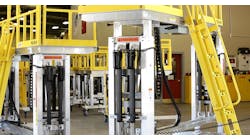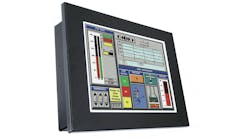In this episode, editor in chief Mike Bacidore is joined by Derrick Stacey, global product manager for ACOPOS 6D and SuperTrak Product families at B&R Industrial Automation, to talk about transport and process functions, as well as the distinctions between a platform and a group of products.
Transcript
Mike: Hello, and welcome to today's episode of Control Intelligence. I'm Mike Bacidore, editor-in-chief of Control Design, and your host for today's podcast. In this episode, I'm joined by Derrick Stacey, who's the global product manager for ACOPOS 6D and SuperTrak ProductFfamilies at B&R Industrial Automation. We'll be talking about transport and process functions, as well as the distinctions between a platform and a group of products.
Over the past few years, some trends have emerged under the Industry 4.0 and IIoT umbrellas. These range from smarter sensors that can be attached throughout the equipment to gather data where previously it just wasn't feasible, to cloud computing solutions for aggregating and analyzing this data to be used for services such as asset performance monitoring, preventive maintenance and digital twinning. These solutions are rarely core to the equipment, but even without a one-stop shop solution, the driver here is the value these additions bring to the end-user through lower unplanned downtime, increased OEE and other direct operational benefits.
B&R has introduced products with features designed to maximize the capabilities of equipment by increasing throughput, efficiency and flexibility, which is valuable to OEMs and integrators that want to leverage their offerings to end-users. Industry often thinks of adaptive systems such as ACOPOStrak and ACOPOS 6D as replacements for traditional Motion Systems, like conveyors or dials. But B&R wants to change this thinking and show the industry that by considering these technologies as the platform to build the system, it will become easier to quantify the value that these products bring through their more seamless fit with the data gathering and analysis trends that are driving these industry 4.0 and Industrial Internet of Things trends.
Using ACOPOStrak and ACOPOS 6D provides advanced motion control, integrated process control and high-quality system data from the heart of the machine without the integration steps of piecing together a custom solution. Derrick Stacey is based out of Atlanta and has been with B&R for the past nine years. He spent most of his career focusing on the adoption of mechatronic systems such as ACOPOStrak, SuperTrak, and ACOPOS 6D into the field and educating everyone from controls engineers, and plant managers to directors of innovation on how they can benefit from such systems. It started with early digital twins and feasibility studies to fully realize automated lines based on these leading-edge technologies. Derrick is the Global Product Manager for ACOPOS 6D and SuperTrak Product Families at B&R. And he's supporting equipment designers, integrators, and end-users to get the most out of these powerful products.
Derrick, welcome.
Derrick: Thank you, Mike. Appreciate it.
Mike: You bet. The automation industry as a whole is always hearing technology suppliers talk about how much faster, better and more flexible a new product is. So, can you explain first to us how is B&R looking at that a little differently?
Derrick: Yeah. So, we sort of see those statements as sort of incremental improvements. And by no means does that mean that continuously improving our products and solutions has become unimportant, but rather that we need to look at specifically the mechatronics technologies, the track systems, ACOPOStrak, planar systems, like ACOPOS 6D, and look at them, what we see that they can offer. When we're not simply asking them to be sort of faster and more flexible transport or conveyance, the value that you uncover really comes to sort of a step change. When you look at it from a holistic approach of starting to design with these technologies at the core of the machine and the machine line, that's where the real innovation and differentiation is created.
Mike: Right. So, you're talking more as a total holistic solution, rather than just implementing something as a device, say? Is that correct?
Derrick: Right. Right. So, when you say, "Okay, my motion is 10% faster," you've quantified and you're like, great, that for me, okay. If I can move 10% more things through my machine, okay, that's a data point at which I can use to say, "Okay, what does it affect my throughput overall?" But it's not just about that, right? Because now, there are bigger questions asked of machine builders and integrators from their end-user is, like, how do I get more data out? How do I anticipate issues? How can you help me run my factory better and make sure my products are better and have more intelligence around them versus just 10% more? Yes, that will sell a machine but it only goes so far to really answer the burning questions.
Mike: Right. So, then, what is the big distinction between, say, a platform instead of just a group of motion products? Is it just that the ability to measure throughput or is there a bigger distinction?
Derrick: Yes. So, my experience over the last few years is sort of working on educating everybody that I talk to about how to leverage these technologies. Often we're sort of dragged into a, "well, it's just a smarter conveyor sort of conversation," and you know, "oh, well, it operates under the same principles as a servo." So, now, we start to shift the discussion to more often than not motion profiles, RMS current, loop tuning. But all of a sudden now, you've sort of put a box around what it brings, because you're just seeing it as purely transportation, right, using the servo as an analog. But to really see them as a platform, sort of, all of a sudden changes your thought process, and it can bring the most value, the highest possible value, when used as the sort of foundational technology, right?
These technologies are often designed to bridge the mechanical, electrical controls and even really digital services needs of the next generation of machines. So, when you think of it more as a platform with which it's the foundation that you build upon, now it's not just, "well, how fast does it go?" And "how much current do I get out of it?" It's now all of a sudden, "what data does it give me? How can it change or improve my overall architecture from a controls perspective? How can I leverage and give more freedom and flexibility for my mechanical designers to be a little bit, you know, to use that sort of cleverness and some of that experience they have, right?" Once you sort of take it off the table of focusing only on timing charts and motion profile, all of a sudden now that creativity and that engineering juice starts to flow, and you can get something sort of more than the sum of its parts.
Mike: Right. It makes perfect sense then, yes. So, in terms of ACOPOS, can you explain in a little more detail how, say ACOPOStrak, and ACOPOS 6D merge those varied transport and process functions, say, within OEM equipment where you're tapping into that creativity?
Derrick: Yeah, exactly. You know, I just want to reiterate that this is where the fun is, right, where the designers can really sort of run a little bit more free. I mean, in the simplest use case, right, we take the standard approach, which is, how do we leverage the controlled motion that these transport systems bring to remove external axes of motion from their process, to shrink process station equipment, to simplify it by putting a little bit of that motion burden on the transport system, because it's more accurate. It's got more controllability than, say, a standard conveyor or an indexing ring.
But when we start to look at sort of letting its scope expand, now, all of a sudden, you could add sensor data. You can start to do audit trail. You can start to add things without product sensors all over your machine, which eliminates a lot of wiring throughout the whole scope of it. You don't have to have as many sensors on machines that they need to check at each step, well, okay, what serial number am I working on at what time. That can all be sort of driven into the smarts of the transport system. And now, all of a sudden, your machine starts to change. Just the shape of it can also be a big change here.
Often traditional systems, you're building your equipment around the outside, because, again, with constraints, you've got mechanical things that are all filling your space. You've got drive trains you gotta keep an eye on. Here, because it's sort of self-contained from a motion standpoint, now, you can use, say, the volume and height above your system or inside the track space. And now, all of a sudden, the area that you're using inside of your factory floor becomes maybe a little narrower, a little taller, that's sort of free space, free volume inside a manufacturing plant. So, now, you might be able to fit two lines, where one might have been using a traditional system. So, all of a sudden now, not only just the per process, design changes, the line design, and the layout, all of a sudden is like, okay, I've got a whole new dimension for me to take advantage of, just by its very nature. And that's really only scratching the surface.
Mike: Sure. Sure. That's a complete new way of thinking and in multiple dimensions, as well—vertically, not only horizontally. What about the end-user industries that are taking advantage of this? At least currently or even in the future, what do you foresee in terms of those industries that are taking advantage of ACOPOS? Which industries are they?
Derrick: Yeah, that's a fun one because rarely can you say there are similarities in how automotive, consumer electronic, pharmaceutical, cosmetic, food and beverage manufacturers operate. But what's kind of neat is with this technology, they're all starting to use and are currently leveraging in their plants these technologies. So, all of a sudden, now, it really is fairly ubiquitous because of what it brings, right? It is the traceability that you need in industries that use good manufacturing, right?
You've got ones where, the cleanliness, or the washdown capabilities need to be utilized and ACOPOStrak, being a fully stainless steel product, means that you can leverage it in clean environments, dirty environments, washed-out environments, the assembly process steps, right? Again, if you're just trying to use high accuracy positioning, plus all of the benefits now all of the consumer electronics, medical device assembly, automotive, right, all of these things sort of branch across when you look at it from a fundamental problem of how we get the most out of each machine we create or line that we need. And so, it's really quite cool that we sort of draw a line across all of these industries.
Mike: Right. Yeah, it seems almost limitless. You know, the timing is always a key differentiator as well. And it's certainly important to discuss just as much the possibilities as the realities of this in a variety of industries. But when would you say these trends that we're talking about can be realized using B&R's platforms? I mean, how quickly and how much in the future are you anticipating?
Derrick: Yep, that's a great question. So, I frame it up as mechanically speaking, everything is there, right? In the end, we've got the products out in the market, people are using them. But we're starting to see people get a much more mature digital strategy, a much more mature understanding of how the edge or how the cloud can benefit operations, right, as a whole. And once you put these systems in place, you start to design your equipment to sort of lend itself to these connections. What's kind of cool is because the hardware is there and all the data behind it, right, the tracking of wear life, the tracking of friction, the tracking of just how the system itself is operating, and how that then is just a single data point within how the machine is running, how the line is running, again, a lot of the stuff people are still getting comfortable with, right?
I think the IT-OT infrastructure is something everybody has been chasing, and now we're starting to see whole digital platforms and a lot of integrations with AWS and Azure, and things like that. People are really dedicated to this. And now, the missing point is just people pushing their machine designers to leverage both ends. So, the track systems, ACOPOS 6D, ACOPOStrak and the data behind them is there, and now, it's just that connection point. So, I see it's gonna evolve over the next couple of years for people to stop just using it as a transport system and to use it as that platform.
But right now, these products are available, for sure. And now, it's on the designers to leverage that information, right? You know, you leave a good bit on the table when you don't utilize it. The business case is still there, but I think that's where we're going start to see sort of step changes in value is utilizing that, right, scraping the system for all that really good core data for how the system's operating, and then pushing that through to the HMI, showing KPI's operators, passing it up to the edge or the cloud for big data. So, a lot of that stuff, I see that sort of a spectrum, right, on the enterprise level and on the machine level, and now, we're slowly bringing that information up from the sensor to the cloud. And these products are going to be key differentiators in that sort of path.
Mike: Certainly. So many times, new technologies, or new devices, or new platforms for that matter, are introduced sometimes with one intention. And once they're inserted into applications or they're integrated into, say, an end-user system, oftentimes, those applications turn out to be something entirely different just because the end-user says, "You know what? This would work so well in this type of application. Let's try it over here." And all of a sudden, you're realizing some new opportunities that sometimes never even appeared on the radar in the first place. But this certainly has the capabilities for endless types of applications with OEMs and with end-users, I would say.
Derrick: Yeah, and we're excited for these next steps because I know for sure that we haven't uncovered everything. And as we put more and more of them into practice, those good questions that come from the end-user, right, the people who feel the pain, who feel the benefit, the value directly on their lines, right, they're the ones who tend to ask the great questions that then we, and our integrator and OEM partners, have to respond to.
Mike: Absolutely, absolutely. And B&R has done a great job of that throughout the years.
Derrick: Thank you.
Mike: Yes. All right. Well, thanks so much. Thanks to all of our listeners today for joining us on Control Intelligence, the podcast for Control Design magazine. And thanks, of course, to B&R's Derek Stacey for his insights into transport and process functions, as well as platforms. Thanks, Derrick.
Derrick: Appreciate it.
Mike: And if you've enjoyed this episode of Control Intelligence, don't miss our older episodes and subscribe to find new podcasts in the future. You can find our podcast library at controldesign.com or download all episodes via Apple podcasts or Google Play.
Thanks again, Derrick.
Derrick: Have a great day.
For more, tune into Control Intelligence: A Podcast from Control Design Magazine.



